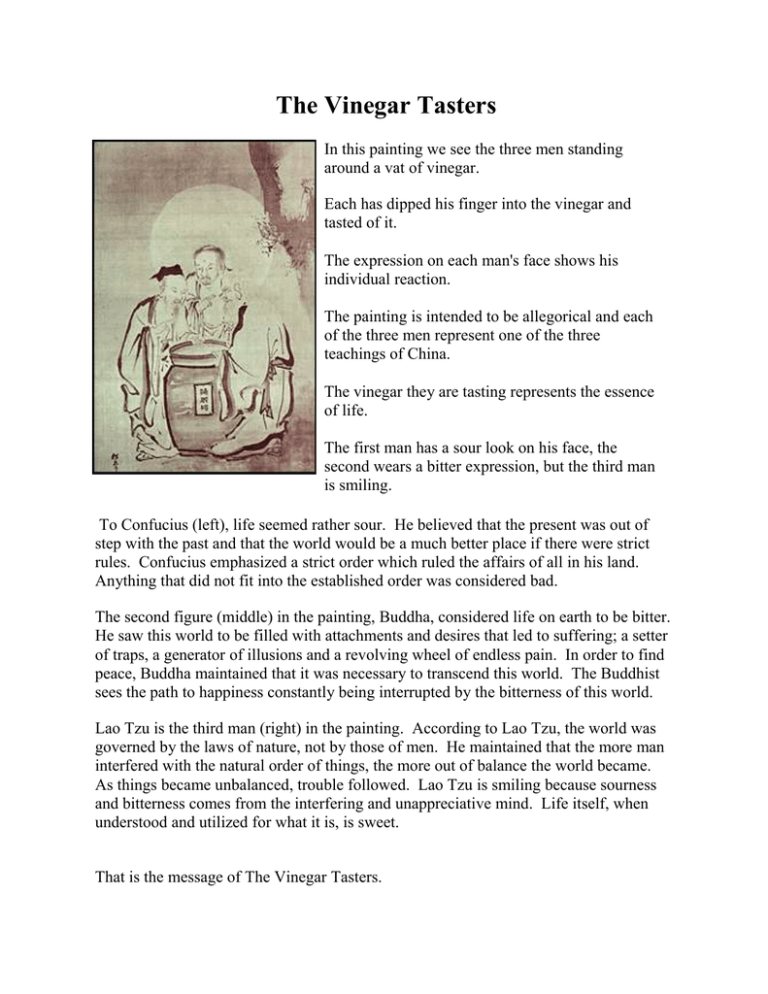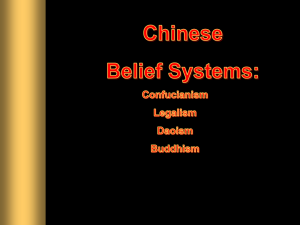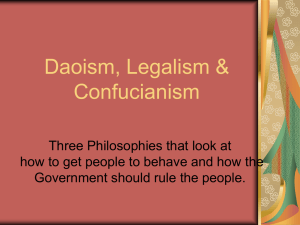The Vinegar Tasters
advertisement

The Vinegar Tasters In this painting we see the three men standing around a vat of vinegar. Each has dipped his finger into the vinegar and tasted of it. The expression on each man's face shows his individual reaction. The painting is intended to be allegorical and each of the three men represent one of the three teachings of China. The vinegar they are tasting represents the essence of life. The first man has a sour look on his face, the second wears a bitter expression, but the third man is smiling. To Confucius (left), life seemed rather sour. He believed that the present was out of step with the past and that the world would be a much better place if there were strict rules. Confucius emphasized a strict order which ruled the affairs of all in his land. Anything that did not fit into the established order was considered bad. The second figure (middle) in the painting, Buddha, considered life on earth to be bitter. He saw this world to be filled with attachments and desires that led to suffering; a setter of traps, a generator of illusions and a revolving wheel of endless pain. In order to find peace, Buddha maintained that it was necessary to transcend this world. The Buddhist sees the path to happiness constantly being interrupted by the bitterness of this world. Lao Tzu is the third man (right) in the painting. According to Lao Tzu, the world was governed by the laws of nature, not by those of men. He maintained that the more man interfered with the natural order of things, the more out of balance the world became. As things became unbalanced, trouble followed. Lao Tzu is smiling because sourness and bitterness comes from the interfering and unappreciative mind. Life itself, when understood and utilized for what it is, is sweet. That is the message of The Vinegar Tasters. Global Studies Confucianism Confucius was born around 551 BCE in Chou times. His parents were nobility, but had become poor when the empire disintegrated into feudal states. When he was about 15 years old, he became quite interested in learning. In those days, only the nobility and royals were allowed education. All the teachers were government officials. It was hard for him to find a way to learn. To solve this, he went to work for a nobleman. This gave him the opportunity to travel to the imperial capital. Confucius studied and learned until he probably was the most learned man of his day. People heard of his knowledge and sent their sons to study with him. He was the first private teacher in China. Confucius taught anyone who was eager to learn. His ideas, called Confucianism, stress the need to develop responsibility and moral character through rigid rules of behavior. Confucianism is not, properly speaking, a religion; it's a way of behaving, so you'll do the right things. Excerpt from The Analects of Confucius, c.400 BCE Do not do unto others, what you would not want others to do to you. If you make a mistake and do not correct it, this is called a mistake. Confucianism, in T'ang times, was a social code of behavior, a very set and rigid code of behavior, that honored ancestors and ancient rituals. Everything had to be done a certain way. One of his rules, for example, was that gentlemen could only display their skill as archers on three hunts a year, in the spring, autumn, and winter. There's a saying about Confucius: "If the mat was not straight, the Master would not sit." You might think to yourself: "Wow. What a fussy." But think about it. In English, if you write a sentence, the first word must start with a capital letter and the last word must end with a period, an exclamation point, or a question mark. Otherwise, it's not a sentence. "If the mat was not straight, the Master would not sit." Today, the Chinese celebrate Confucius Birthday (Teacher's Day), in honor of their ancestor, the teacher, Confucius. The Teachings of Confucius BEING DOING/MEANS ENDS Rén, "bene volen ce, charit y, humanity, love," kindness. The fundamental virtue of Confucianism. Confucius defines it as "Aì rén," "love others." [Analects XII:22] Yì, "right conduct, morality, duty to one's neighbor," righteousness. Lì, "profit, gain, advantage": NOT a proper motive for actions affecting others. The idea that profit is the source of temptation to do wrong is the Confucian ground of the later official disparagment of commerce and industry. The Master said, "The gentleman (chün tzu or ) understands yì. The small man understands lì." [Analects IV:16] Li3, "propriety, good manners, politeness, ceremony, worship." Xiào, "to honor one's parents," filial piety. Yì may be broken down [Analects IV:15] into: zhong1, doing one's best, conscientiousness, "loyalty"; and shù, "reciprocity," altruism, consideration for others, "what you don't want yourself, don't do to others" [Analects XV:24 or 23]. Quoted definitions, Mathews' Chinese-English Dictionary, Harvard, 1972; quotations from Analects translated by D.C. Lau, Penguin Books, 1979 Confucius’ Relationships 1 2 3 4 5 6 4 5 6 Buddhism “Awakened One” (Buddha) Prince Siddhartha Gautama, who would one day be known as the Buddha, began his life as a prince in a kingdom in Ancient India. He was born about 553 B.C.E. He had parents who loved him, many servants to wait on him, the finest clothes, and different palaces for each season of the year. Yet he found his world full of suffering. It upset him that painful old age, sickness, and death were all parts of life in this world. One day, he met a monk. He was amazed that this monk could find calm and peace in a world filled with such sufferings. That day he made a very difficult decision. He decided to leave his wealth, his wife, and his newborn son to become a monk. For the next six years, he traveled throughout India. But the answers he found were not enough. One day, while sitting under a fig tree, an understanding came to him. This understanding was a way to end suffering. That was the day Prince Siddhartha Gautama began to earn a new title, the Buddha, which means, “Awakened One.” Four Noble Truths His journey to find the meaning of life had concluded. The Buddha realized that life is ruled by Four Noble Truths: Life is filled with suffering Suffering is caused by people’s wants Suffering can be ended if people stop wanting things To stop wanting things people must follow t8 basics laws, called the Eightfold Path Eightfold Path These are the laws of the Eightfold Path: 1. To know the truth 2. To intend to resist evil 3. To not say anything to hurt others 4. To respect life, property, and morality 5. To work at a job that does not injure others 6. To try to free one’s mind from evil 7. To be in control on one’s feelings and thoughts 8. To practice appropriate forms of concentration The Middle Way The Eightfold Path was designed to guide people without making life too strict or too easy. The Middle Way is the name Buddhists call lives guided by the laws of the Eightfold Path. Buddha spent the rest of his life traveling around India and sharing his message with everyone. He had many followers, who lived according to the Four Noble Truths. Some of his followers became Buddhist monks. They gave up all they owned and depended on other followers and kind-hearted people to give them food. Their message was one of love. After the Buddha’s death in 483 B.C.E., Buddhism spread rapidly throughout Southern and Eastern Asia. The Wheel An wheel with eight spokes is the symbol for Buddhism and it’s Eightfold Path. Proverbs Buddhists everywhere live by Buddha’s teachings, which were written down as proverbs. Here are two of Buddha’s proverbs from an ancient Buddhist text written about 100 B.C. E. . and The Growth of Buddhism Buddhism values love, wisdom, goodness, clam, and self-control. Buddhists believe that Buddha and his teachings should be honored, that people should try to end suffering, and that they should follow the Eightfold Path. During the Tang Dynasty of China, people thought of Buddhism as a chart of behavior that they could follow to lead them to a life beyond the grave. Buddhism spread from India all over the World through migration ad trade. Today, Buddhism is a major world religion. There are over 375 millions Buddhists in the World. Global Studies Taoism (Daoism) Taoism originated in China and though many people don’t realize it, they often are familiar with its various elements. The Yin and Yang symbol represents the belief that everything consists of a balance of opposites, which is the main theme of Taoism. The “Tao” is defined as the way of nature or the universe. Because the Tao can’t be fully grasped by thought or speech, Taoism is often referred to as the “nameless philosophy.” The goal of life, according to Taoists is to conform to the way of nature, the Tao. Taoism’s main themes are intuition, simplicity, spontaneity, and the way of nature. Some of its main principles include: Tao: the way of nature or the universe Yin/Yang: balance of opposing forces Wu Wei: (non-doing) behavior that is spontaneous, natural, and effortless. Going with the flow. Pu: (the uncarved block) things in their natural state Te: (the flowing power) virtue obtained through balance, compassion and living simply Ch’i: cosmic energy The Yin/Yang Feminine Passive Darkness Cold Weak Earth Moon Masculine Active Light Warmth Strong Heaven Sun Lao Tzu and the Tao Te Ching (The Book of the Way and Virtue) Lao Tzu is thought to have lived between the sixth and third century BCE. He is regarded as the creator of the foundation of the Taoist philosophy. According to a Chinese legend, Lao Tzu was immaculately conceived by a shooting star and born as an eighty-two year old man. After living as a scholar of the Yin-Yang school of philosophy, Lao Tzu wanted to live the rest of his days living out a simple life in the mountains. But he was put under guard and ordered to write down his life’s wisdom. After two days, he returned to the guard with a short manuscript: the Tao Te Ching. It is believed that Lao Tzu was not the only writer of the book, but rather several teachers wrote it together. However, it remains to this day as the basic text of Taoist thought and credit is generally given to Lao Tzu. “Those who speak know nothing: Those who know are silent.” These words, I am told, Were spoken by Lao Tzu. If we are to believe that Lao Tzu, Was himself one who knew, How is it that he wrote a book, Of five thousand words? Taoist Influences on Chinese Culture Acupuncture: 2000 year-old medical procedure that is based on the concept of balancing ch’i (the vital energy that flows throughout the body) by puncturing the skin with hair-thin needles at particular points. I Ching: an ancient scripture about the yin/yang used by Taoist and Confucianists as a form of divination. Tai Chi: a set of smooth, flowing exercises used to improve or maintain health, create a sense of relaxation and keep ch’i flowing. Feng Shui: the ancient Chinese art of placement. Its goal is to achieve harmony, comfort, and balance, first in ones environment and then in one's life. LEGALISM Legalism holds law as the supreme authority. There are three components to Legalism: fa (law), shi (legitimacy), and shu (arts of the ruler). Fa The law. Previously, the law was pretty much at the discretion of the ruler. No one was really sure what the law was, since the ruler could make and change the rules as he saw fit. Supposedly, this was to give the ruler the opportunity to show benevolence in certain circumstances. But obviously, this system made for easy corruption. In Legalism, the law code was written out and made public. All people under the ruler were equal in the eyes of the law. In addition, the system of law ran the state, not the ruler. The ruler and his ministers were simply parts of the state machine--a machine which would ideally run so well that no matter how unworthy the ruler was, the laws would still keep the state going. Laws were enforced by strict reward/punishment. Shi Legitimacy of Rule. Unlike other philosophies, which sought out the wise and virtuous to rule, Legalism puts the emphasis on the power of the position, not the person filling it. Legalism is a pessimistic philosophy--while conceding that it would be wonderful to have a sage for ruler, the reality was that there just weren't many sages around. The practical thing would be to have a system where even an average man could rule and the state would stay intact. Keeping order was the first priority. In other words, whoever was ruler was powerful because the position held power, not because the person possessed any special qualities. Shu Discussions of morality and human nature are irrelevant in Legalism. Benevolence has no place in ruling a state because unless people are ruled by a strong, strict hand, they grow lazy and disrespectful of authority. Policies based on benevolence might work for the short term, but inevitably led to disorder and failure. Daoism and Confucianism looked to the past as the ideal and tried to recreate the past. Confucius' rituals came from the Zhou Dynasty and the Dao is the original state of all things. Legalism disregards the past-conditions were different back then, so what worked back then would not necessarily work in the present time. fa jia Fa = law Jia = school of thinking The Two Handles Rewards and Punishments One of the most important parts of the philosophy was the concept of the two handles of government. The two handles are rewards and punishments. Legalists believe that people are not smart enough to know how to behave. The only way to get people to follow the rules is to reward people for following the rules and harshly punish those who do not. “...rewards should be rich and certain so that the people will be attracted by them; punishments should be severe and definite so that the people will fear them; and laws should be uniform and steadfast so that the people will be familiar with them. Consequently, the sovereign should show no wavering in bestowing rewards and grant no pardon in administering punishments, and he should add honor to rewards and disgrace to punishments--when this is done, then both the worthy and the unworthy will want to exert themselves…” --Han Feizi ************************************** Founders of Legalism Like Daoism, Legalism had no single founder but instead, a couple of people who had similar ideas. Han Feizi, as a student, was taught in the Confucian tradition. Because of a problem with stuttering, he did not go the way most wandering philosophers of this age did: making the rounds of kings' courts and making speeches. Instead, he wrote. His book, the Han Feizi, brought him some prominence during his life and ended up being the main text of the school of Legalism. Han Feizi died as a result of political intrigue in 233 BCE, but Legalism would go on to become the philosophy which finally managed to unify China. Shangzi (Gungsun Yang) also contributed to Legalism. He traced the cause of the chaos of the time back to a growing population. According to him, this caused a scarcity of resources which led to war and strife. Shangzi saw a strong government according to law as the solution to the problem. Legalism does not identify itself through the use of symbols. Source: http://www.geocities.com/tokyo/springs/6339/Legalism.html






